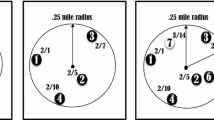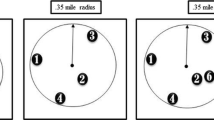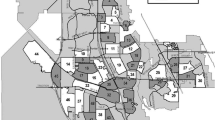Abstract
The discovery of near-repeat patterns of criminal offending indicates that certain crimes possess a property of contagiousness that increases the likelihood of future crime events within a close spatio-temporal proximity to earlier offenses. This study investigates whether a near-repeat pattern of offending exists for motor vehicle theft (MVT) in Lincoln, Nebraska. Results indicate the presence of a near-repeat pattern of MVT offending. Specifically, there is a 96 percent increased likelihood of an MVT occurring between one and two blocks, and within 2 weeks of an earlier MVT beyond what would otherwise be expected. Having identified such a pattern, socio-demographic characteristics are used to estimate the relationship between structural correlates of the community and both all MVTs and the MVT ‘initiator’ events that represent the initial offenses that spawn patterns of near-repeat offending. Results indicate that both initiator events and MVTs in general are more likely to occur in disadvantaged communities. Implications of these findings are discussed.
Similar content being viewed by others
References
Anselin, L., Cohen, J., Cook, D., Gorr, W. and Tita, G. (2000) Spatial analyses of crime. In: D. Duffee (ed.) Criminal Justice 2000: Volume 4. Measurement and Analysis of Crime and Justice. Washington DC: National Institute of Justice, pp. 213–262.
Baumer, E. (2002) Neighborhood disadvantage and police notification by victims of violence. Criminology 40 (3): 579–616.
Bennell, C. and Canter, D.V. (2002) Linking commercial burglaries by modus operandi: Tests using regression and ROC analysis. Science & Justice 42: 153–164.
Bennell, C. and Jones, N.J. (2005) Between a ROC and hard place: A method for linking serial burglaries by modus operandi. Journal of Investigative Psychology and Offender Profiling 2 (1): 23–41.
Bernasco, W. (2008) Them again? Same-offender involvement in repeat and near repeat burglaries. European Journal of Criminology 5 (4): 411–431.
Blau, P. (1977) Inequality and Heterogeneity. New York: Free Press.
Bowers, K.J. and Johnson, S.D. (2004) Who commits near repeats? A test of the boost explanation. Western Criminology Review 5 (3): 12–24.
Bowers, K.J. and Johnson, S.D. (2005) Domestic burglary repeats and space-time clusters: The dimensions of risk. European Journal of Criminology 2 (1): 67–92.
Bureau of Justice Statistics. (2006) Criminal Victimization in the United States, 2005 Statistical Tables. BJS report, 2006, http://bjs.ojp.usdoj.gov/content/pub/pdf/cvus05.pdf, accessed 5 April 2011.
Clarke, R.V. and Harris, P.M. (1992) Auto Theft and Its Prevention. Chicago, IL: University of Chicago Press.
Copes, J.H. (1999) Routine activities and motor vehicle theft: A crime specific approach. Journal of Crime and Justice 22 (2): 125–146.
Copes, J.H. (2003) Streetlife and the rewards of auto theft. Deviant Behavior 24: 309–332.
Farrell, G. and Pease, K. (1993) Once Bitten, Twice Bitten: Repeat Victimisation and Its Implications for Crime Prevention. London: Home Office.
Farrell, G., Phillips, C. and Pease, K. (1995) Like taking candy: Why does repeat victimization occur? British Journal of Criminology 35 (3): 384–399.
Federal Bureau of Investigation. (2000) Crime in the United States: Uniform Crime Reports, 2000. Washington DC: U.S. Government Printing Office.
Federal Bureau of Investigation. (2006) Crime in the United States: Uniform Crime Reports, 2006. Washington DC: U.S. Government Printing Office.
Fleming, Z., Brantingham, P.L. and Brantingham, P.J. (1994) Exploring auto theft in British Columbia. In: R.V. Clarke (ed.) Crime Prevention Studies, Vol. 3. Monsey, NY: Criminal Justice Press, pp. 47–90.
Grubesic, T.H. and Mack, E.A. (2008) Spatio-temporal interaction of urban crime. Journal of Quantitative Criminology 24 (3): 285–306.
Henry, L.M. and Bryan, B.A. (2000) Visualising the spatio-temporal patterns of motor vehicle theft in Adelaide, South Australia. Paper presented at Crime Mapping: Adding Value to Crime Prevention and Control, Meeting of the Australian Mineral Foundation; August, Adelaide, South Australia.
Hope, T. and Hough, M. (1988) Area, crime and incivility: A profile from the British crime survey. In: T. Hope and M. Sham (eds.) Communities and Crime Reduction. London: Home Office, pp. 30–47.
Hunter, A. (1974) Community change: A stochastic analysis of Chicago's local communities, 1930–60. American Journal of Sociology 79 (4): 923–947.
Janson, C.-G. (1980) Factorial social ecology: An attempt at summary and evaluation. Annual Review of Sociology 6: 433–456.
Johnson, S.D. and Bowers, K.J. (2004a) The burglary as clue to the future: The beginnings of prospective hot-spotting. European Journal of Criminology 1 (2): 237–255.
Johnson, S.D. and Bowers, K.J. (2004b) The stability of space-time clusters of burglary. British Journal of Criminology 44 (1): 55–65.
Johnson, S.D. and Braithwaite, A. (2009) Spatio-temporal modeling of insurgency in Iraq. In: J.D. Freilich and G.R. Newman (eds.) Crime Prevention Studies, Vol. 25. Cullompton, UK: Willan, pp. 9–32.
Johnson, S.D., Summers, L. and Pease, K. (2006) Vehicle Crime: Communicating Spatial and Temporal Patterns. London: UCL Jill Dando Institute of Crime Science.
Johnson, S.D. et al (2007) Space-time patterns of risk: A cross national assessment of residential burglary victimization. Journal of Quantitative Criminology 23 (3): 201–219.
Johnson, S.D., Summers, L. and Pease, K. (2009) Offender as forager? A direct test of the boost account of victimization. Journal of Quantitative Criminology 25 (2): 181–200.
Knox, E.G. (1964) Epidemiology of childhood leukemia in Northumberland and Durham. British Journal of Preventive and Social Medicine 18 (1): 17–24.
Land, K.C., McCall, P.L. and Nagin, D.S. (1996) A comparison of Poisson, negative binomial, and semiparametric mixed Poisson regression models: With empirical applications to criminal careers data. Sociological Methods & Research 24 (4): 387–442.
Lersch, K.M. (2004) Space, Time, and Crime. Durham, NC: Carolina Academic Press.
Linden, R. and Chaturvedi, R. (2005) The need for comprehensive crime prevention planning: The case of motor vehicle theft. Canadian Journal of Criminology and Criminal Justice 47 (2): 251–270.
Long, J.S. and Freese, J. (2006) Regression Models for Categorical Dependent Variables Using Stata, Vol. 2. College Station, TX: Stata Press.
Lu, Y. (2003) Getting away with the stolen vehicle: An investigation of journey-after-crime. The Professional Geographer 55 (4): 422–433.
Mayhew, P. and Braun, G. (2004) Parking lot security. In: M.G. Maxfield and R.V. Clarke (eds.) Understanding and Preventing Car Theft, Vol. 17. Monsey, NY: Criminal Justice Press, pp. 121–146.
Miethe, T.D. and Meier, R.F. (1994) Crime and its Social Context: Toward an Integrated Theory of Offenders, Victims, and Situations. Albany, NY: State University of New York Press.
Morgan, F. (2000) Repeat burglary in a Perth suburb: Indicator of short-term or long-term risk. In: G. Farrell and K. Pease (eds.) Repeat Victimization: Crime Prevention Studies, Vol. 12. Monsey, NY: Criminal Justice Press, pp. 83–118.
Osgood, D.W. (2000) Poisson-based regression analysis of aggregate crime rates. Journal of Quantitative Criminology 16 (1): 21–43.
Pease, K. (1998) Repeat Victimisation: Taking Stock. London: The Home Office.
Plouffe, N. and Sampson, R. (2004) Auto theft and theft from autos in parking lots in Chula Vista, CA: Crime analysis for local and regional action. Crime Prevention Studies 17: 147–171.
Polvi, N., Looman, T., Humphries, C. and Pease, K. (1990) Repeat break-and-enter victimisation: Time course and crime prevention opportunity. Journal of Political Science and Administration 17 (1): 8–11.
Ratcliffe, J.H. and Rengert, G.F. (2008) Near repeat patterns in Philadelphia shootings. Security Journal 21: 58–76.
Rengert, G., Piquero, A. and Jones, P. (1999) Distance decay reexamined. Criminology 37 (2): 601–619.
Rossmo, D.K. (2000) Geographic Profiling. Boca Raton, FL: CRC Press.
Sallybanks, J. and Brown, R. (1999) Vehicle Crime Reduction: Turning the Corner. London: Home Office.
Sampson, R.J., Raudenbush, S.W. and Earls, F. (1997) Neighborhood and violent crime: A multilevel study of collective efficacy. Science 277: 918–924.
Shevky, E. and Bell, W. (1955) Social Area Analysis: Theory, Illustrative Application, and Computational Procedures. Stanford, CA: Stanford University Press.
Taylor, R.B. and Covington, J. (1988) Neighborhood changes in ecology and violence. Criminology 26 (4): 553–589.
Townsley, M.T., Homel, R. and Chaseling, J. (2003) Infectious burglaries: A test of the near repeat hypothesis. British Journal of Criminology 43 (3): 615–633.
Townsley, M.T., Johnson, S.D. and Ratcliffe, J.R. (2008) Space-time dynamics of insurgent activity in Iraq. Security Journal 21: 139–146.
Walsh, J.A. and Taylor, R.B. (2007a) Community structural predictors of spatially aggregated motor vehicle theft rates: Do they replicate? Journal of Criminal Justice 35 (3): 297–311.
Walsh, J.A. and Taylor, R.B. (2007b) Predicting decade-long changes in community motor vehicle theft rates: Impacts of structure and surround. Journal of Research in Crime and Delinquency 44 (1): 64–90.
Weisel, D.L., Smith, W.R., Garson, G.D., Pavlichev, A. and Wartell, J. (2006) Motor Vehicle Theft: Crime and Spatial Analysis in a Non-urban Region. Rockville, MD: National Institute of Justice.
Zeigenhagen, E. (1976) The recidivist victim of violent crime. Victimology 1 (4): 538–550.
Author information
Authors and Affiliations
Rights and permissions
About this article
Cite this article
Lockwood, B. The presence and nature of a near-repeat pattern of motor vehicle theft. Secur J 25, 38–56 (2012). https://doi.org/10.1057/sj.2011.5
Published:
Issue Date:
DOI: https://doi.org/10.1057/sj.2011.5




